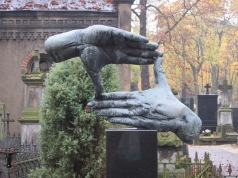• (2009) Lutosławski: Concerto for Orchestra
Witold Lutosławski: Concerto for Orchestra
programme note written for
Polish Radio National Symphony Orchestra, cond. Jacek Kaspszyk
Cadogan Hall, London, 30 April 2009
1. Allegro maestoso (Intrada)
2. Vivace (Capriccio notturno e Arioso)
3. Andante con moto – Allegro giusto (Passacaglia, Toccata e Corale)
Lutosławski (1913-94) finished the Concerto for Orchestra two weeks after Andrzej Panufnik left Poland for England via Zürich. It symbolised a passing of focus from one composer to another in the difficult atmosphere of post-Stalinist Poland. Lutosławski must have been apprehensive about the reception that his new work might receive at its premiere in Warsaw on 26 November 1954. He too had been heavily criticised, notably for his First Symphony (1941-47) and he had worked on this, his largest work, since 1950.
He need not have worried: his new work was a triumph and has remained a staple of the repertoire not only in Poland but across the world. Yet Lutosławski was always ambivalent about it and his other works from the early 1950s (unlike Panufnik who, certain revisions aside, was steadfastly loyal to his ‘Polish’ pieces). He once said that the Concerto was “a marginal thing for me (in spite of the fact that it is a clever piece of work, and, for that matter, a ‘spectacular’ thing, which is just what appeals to the public)”. One reason for Lutosławski’s attitude (he rarely conducted the Concerto and recorded it only once, with tonight’s orchestra) may have been that, at the moment that Panufnik decided to abandon folk sources at the end of the 1940s, Lutosławski resolved to embrace them. He was the only Polish composer at the time to do this so wholeheartedly. This kept him in the authorities’ good books, but he felt that he had somehow compromised the compositional direction that he really wanted to take.
Critical and audience reception, however, has had no such doubts, and there are many good reasons why this has been so. These are centred on the relationship between Lutosławski’s compositional and structural techniques and his folk sources. He uses his sources as raw material to fashion quite different musical identities, be they short and often unremarkable motifs or long-breathed themes. Zofia Lissa at the time and the American composer Steven Stucky in 1981 identified, with Lutosławski’s help, eight folk tunes. They came from two Mazowsze volumes in Oskar Kolberg’s mammoth nineteenth-century collection of folk materials. In fact, there are at least three more tunes, as the present author discovered when he unearthed a folder of ‘Folk Materials’ in the composer’s house in 2002. In this folder (now in the Paul Sacher Stiftung in Basle) were several sheets of transcriptions from Kolberg, 69 tunes in all, from which Lutosławski chose his eleven. It is evident from these sheets that he was looking for certain types of tunes, primarily in 3/8, that would fit his symphonic vision.
In the opening of the Intrada, for example, several short motifs are woven inconspicuously together around the main idea, which soaks up the limelight. The texture is thereby subtly enriched. After the first climax, another theme (on the horns) is stretched beyond its original dimensions, and this becomes one of the work’s principal threads, reappearing in the finale. After several gritty climaxes, the movement relaxes back into the opening material, now in the upper registers.
The ensuing Vivace is effectively a scherzo and trio, the outer sections displaying a Mendelssohnian fleetness of foot. The folk disguises here are masterly. The high strings chords that appear after the initial ‘nocturnal’ scurryings are derived from one melody, while the grandiose theme introduced by the trumpets in the central Arioso (and what an atypically aggressive arioso this is) presents a powerful example of thematic extension of another.
In later life, Lutosławski developed his orchestral structures into what has been called ‘end-accented’ forms. The finale of the Concerto for Orchestra is an early prototype. The first two movements, and the Passacaglia that opens the finale, are deliberately fashioned to lead to and not outweigh the Toccata. The Passacaglia takes a folk melody as its main idea (first presented by the double basses in the ninth bar) and passes it up from the lowest registers to the highest while increasingly muscular variations envelop it. The Toccata is based on the same melody and is soon joined by the central theme of the Intrada, emphasising that it is the symphonic dimension, animated by brilliant orchestration as befits a Concerto for Orchestra, and not the folk material that really matters. A cheeky little theme in 2/4 interrupts (this is one of the previously unacknowledged folk melodies) before the music races forward in brass fanfares. At this point a chorale, apparently not folk-based, emerges on oboes and clarinets. Thereafter, many of the important themes combine helter-skelter as the music drives towards a series of codettas (a few conductors have been known to cut some of these), culminating in a triumphant enunciation of the chorale.
While Lutosławski’s Concerto for Orchestra has proved to have enduring popularity, it is worth considering Lutosławski’s subtlety of approach to its composition in the early 1950s. His use of folk-based material was ingenious and of a rare quality. The Concerto’s rhetoric is even more astonishing, as it accommodated the requirements of the time that compositions should move from entanglement and struggle (Intrada) to clarity and victory (Corale) and yet it simultaneously, and brilliantly, transcended the socialist-realist context, hence its continuing appeal. It was a signal of Lutosławski’s future eminence on both the Polish and the world stage.
© 2009 Adrian Thomas
☚
PROG NOTES
(repertoire list)
